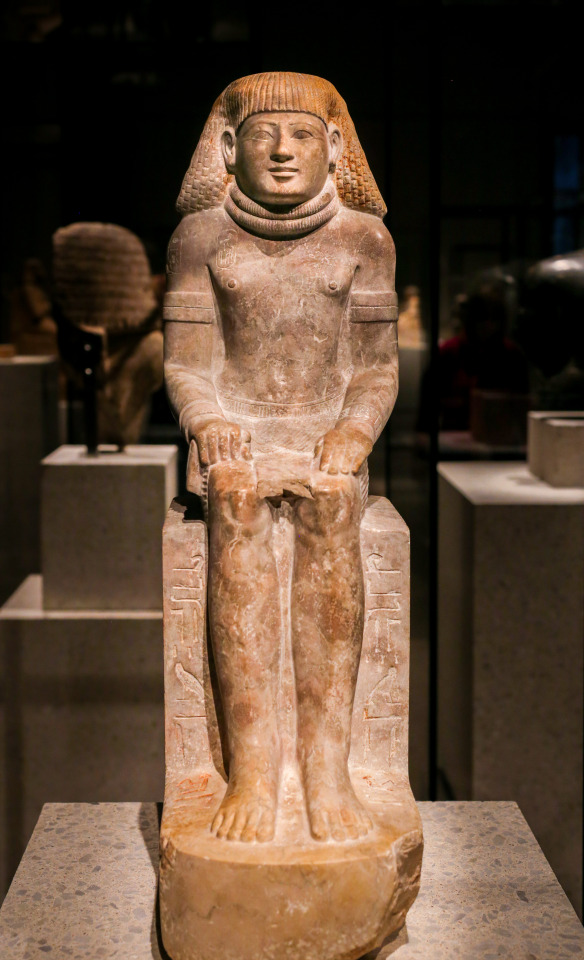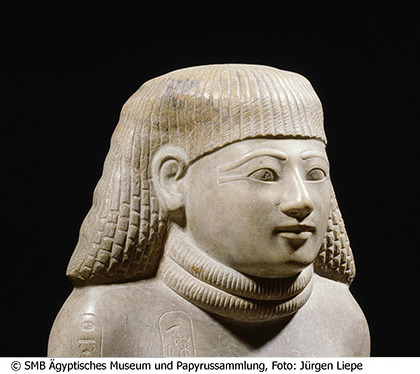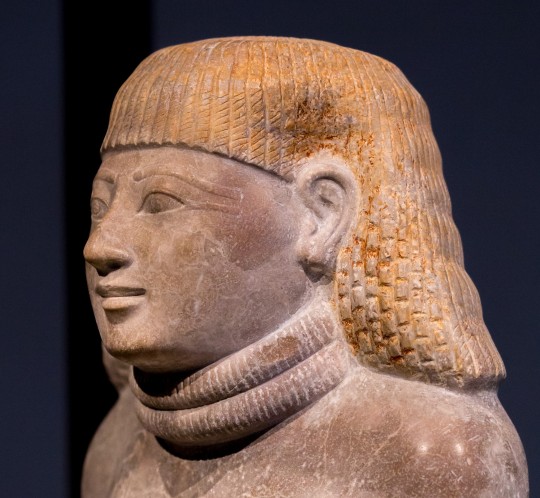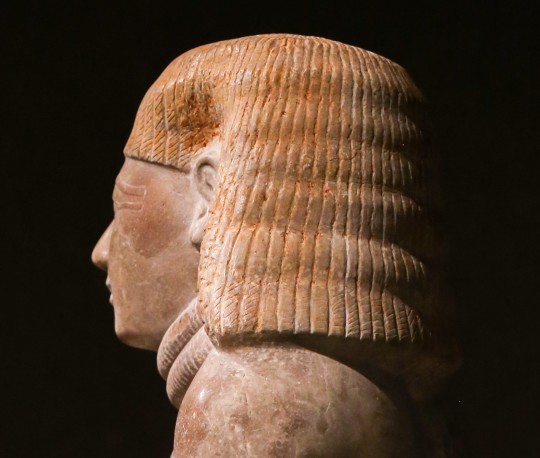#Ägyptisches Museum und Papyrussammlung
Explore tagged Tumblr posts
Text






Sitting figure of Maja - Staatliche Museen zu Berlin Collections
Inventory Number: ÄM 19286 Tutmose III (18th Dynasty, New Kingdom, Egypt) Location Information: Akhmim (? / Egypt / Middle Egypt)
Description:
Maja was a high official of the provincial administration. He was installed as Gouverneur and head of the Priests in the 10th upper egyptian district by king Tutmose III, who's name is written on the chest and right upper arm. His grave was found in the necropolis of the main settlement of that district and it is speculated that this figure was also from there. Maja sits upright on a simple stool. The text tells us names and titles of the deceased, as well as the sacrificial rites for the local deities. He is dressed in a short skirt, originally reserved for the kings, but later also found with private persons. He holds in his right hand a sweat cloth, while the left isflat on his skirt. The round expressionless face is, like the entire figure, structured very formal. A wig that was in keeping with the taste of the time was literally placed over the head. The two necklaces, consisting of disc pearls, as well as the massive upper and lower arm bracelets, are awards made of gold that the king had given him. They probably indicate former military service.
Credit: Staatliche Museen zu Berlin, Ägyptisches Museum und Papyrussammlung / Jürgen Liepe
Other Images Used for Display:
Wikimedia Commons, @ User ArchaiOptix
Wikimedia Commons, @ User ArchaiOptix
Wikimedia Commons, @ User ArchaiOptix
Wikimedia Commons, @ User ArchaiOptix
Wikimedia Commons, @ User ArchaiOptix
#Sitting figure of Maja#Staatliche Museen zu Berlin#Ägyptisches Museum und Papyrussammlung#ÄM 19286#dynasty 18#new kingdom#new kingdom pr#Akhmim#middle egypt#upper egypt#mens clothing#NKPRMC
4 notes
·
View notes
Text
The Neues Museum by Kaléa Daniels and Glorie Michelle Romero Elvir Enamorado

View On WordPress
#femGeniusesInBerlin#Ägyptisches Museum und Papyrussammlung#Egyptian Museum and Papyrus Collection#German colonialism#Glorie Elvir#Heidi R. Lewis#Kaléa Daniels#Neues Museum
0 notes
Text

A goddess whose name partly reads "Mistress of Heaven, Mistress of Dread" ducks her snake-head under the hieroglyphs on the Amduat papyrus of Shed-Mut.
Where: Staatliche Museen zu Berlin, Ägyptisches Museum und Papyrussammlung
When: Third Intermediate Period, 21st Dynasty
#Ancient Egypt#papyrus#Amduat#Staatliche Museen zu Berlin#Third Intermediate Period#21st Dynasty#Shedmut
20 notes
·
View notes
Text
𝐡𝐞𝐚𝐝𝐜𝐚𝐧𝐨𝐧 — 𝐩𝐞𝐫𝐦𝐚𝐧𝐞𝐧𝐭 𝐫𝐞𝐬𝐢𝐝𝐞𝐧𝐜𝐞 .
As Secretary General of the Ministry of Tourism and Antiquities, it is Isis' job to assist in the restoration and preservation of Egyptian artefacts, as well as oversee all of Egypt's archaeological museums, secure the return of stolen or lost artefacts, implement strategies to reduce theft and destruction of artefacts, and boost tourism through the education of Egyptian history and culture.
The wide scope of her duties means that Isis has a demanding schedule that often requires her to travel abroad to meet with various leaders, archaeologists, and professors to ensure that any Egyptian artefacts in their museums are taken care of appropriately, or returned to their rightful place in Egypt if not.
All of that to say, Isis has lived in several different locations since the end of the series. Following Atem's return to the afterlife, Isis was tasked with overseeing the safe transfer and return of some artefacts from the British Museum in London, which required her to live there temporarily for a year.
By the time the events of DSOD pass, Isis is once again transferred; this time to Berlin. Her current job is as the Museum Curator for the Ägyptisches Museum und Papyrussammlung ( Egyptian Museum and Papyrus Collection ) and Berlin currently acts as her permanent residence; though, again, she is often required to travel abroad for events and various tasks related to her occupation.
It is worth noting that, although not fluent by any means, Isis has a conversational understanding of German and can communicate easily enough with her German colleagues with minimal assistance from a translator.
5 notes
·
View notes
Video
youtube
Liked on YouTube: How the Ancient Invocation of the Headless God became Aleister Crowley's Ritual of the Bornless One || https://www.youtube.com/watch?v=wI41hfd8CXE || Aleister Crowley's Ritual of the Bornless One and Liber Samekh has its ancient origins in Greek Magical Papyrus V. 96-172, a c. 4th century exorcistic incantation invoking the Akephalos or the "Headless God." Join me in this episode as I explore the original "Stele of Ieu the Hieroglyphist in His Letter," the mysterious "Headless God," before turning to how this ancient ritual became foundational in the history and practice of contemporary occultism. In memoriam Jake Stratton-Kent Make Sure to Subscribe & Consider supporting Esoterica by becoming a monthly Patron - https://ift.tt/G9DsJjN a one time donation - https://ift.tt/0BaHM4U or the Super Thanks - Your support is profoundly appreciated! Recommended Readings: British Library - Papyrus 46 - https://ift.tt/ZTkVEIz P 5026 - Staatliche Museen zu Berlin, Ägyptisches Museum und Papyrussammlung - https://ift.tt/QkhItOp Betz - The Greek Magical Papyri in Translation: Including the Demotic Spells - 978-0226044477
2 notes
·
View notes
Text

14 March 2024: Berlin, Nefertiti
Ägyptisches Museum und Papyrussammlung Collection
0 notes
Text

Standfigur des Königs Amenemhet III.
© Foto: Ägyptisches Museum und Papyrussammlung der Staatlichen Museen zu Berlin - Preußischer Kulturbesitz
Fotograf/in: Sandra Steiß
#smb#museumsinsel#staatliche museen zu berlin#sandra steiß#sandra steiss#ägyptisches museum und papyrussammlung#amenemhet iii#ancient egypt#art#statue#sculpture#mupl#ancient#ancient art#egypt#egypt art#amenemhat iii#12th dynasty#twelfth dynasty of egypt#dynasty xii#twelfth dynasty#standfigur#altes ägypten#antike#antikes ägypten#preußischer kulturbesitz#staatlichemuseenzuberlin
16 notes
·
View notes
Photo

Fragment of a statue of King Khafre. © Foto: Ägyptisches Museum und Papyrussammlung der Staatlichen Museen zu Berlin - Preußischer Kulturbesitz
5 notes
·
View notes
Photo

@littlewarsaw #seems show at innen zürich extended until february 25, 2021 / image credit: little warsaw, the body of nefertiti, ägyptisches museum und papyrussammlung berlin, 2003 #2020 #innenbooks #stadtzürich www.innenbooks.com
11 notes
·
View notes
Photo

Detail of an unfinished limestone statuette of Queen Nefertiti as a middle-aged woman. On her bald head she wears the cap crown. It was recovered from the workshop of Thutmose, the Master of Works, in Akhetaten (modern day el-Amarna). This sculpture (ÄM 21263) is now in the Neues Museum, Berlin, Germany. Photo (edited for size): © Staatliche Museen zu Berlin, Ägyptisches Museum und Papyrussammlung / Sandra Steiß. "... The face of the figure is that of a woman well past her prime; the cheeks are plumper than usual making the eyes appear small, the skin sags and the mouth is dragged downwards giving an expression of sadness tinged with resignation..." ― Tyldesley, Joyce, Nefertiti: Egypt's Sun Queen (Revised edition), Penguin Books Ltd, London, England, 2005. #iregipto #egyptpassion #discoveregypt #thisisegypt #egypt #MBPlanet #egypt https://www.instagram.com/p/CLocunGHH4e/?igshid=xojcq0n7l5t6
4 notes
·
View notes
Photo

June 10, 2020 | The Ruby Ring
The Ruby Ring is a TV movie from 1997. Directed by Harley Cokeliss, it’s about a young woman named Lucy McLaughlin. After her father loses his job, the family moves in with her grandmother. Her grandmother gives her a magic ring, which grants her two wishes. But as is always the case with magic, things don’t go as is wished for. The story is set in the UK (Scotland specifically, I believe), and, frankly, there’s nothing about Egypt in this film... except! Except in one scene, very early on in the movie (at 4:46), we see an artwork on a wall of the grandmother’s house. It’s a painting/drawing of the iconic Queen Nefertiti’s bust (below). The bust is currently located at the Egyptian Museum of Berlin (Ägyptisches Museum und Papyrussammlung). A nice prop!

[Screenshot of a scene from The Ruby Ring on YouTube; Image of Nefertiti’s bust from Wikimedia Commons]
#l'egypte est partout#the ruby ring#egypt in art#queen nefertiti#nefertiti#vague association to egypt#ancient egyptian art#Ancient Egypt
10 notes
·
View notes
Text






Sitting figure of Maja - Staatliche Museen zu Berlin Collections
Inventory Number: ÄM 19286 Tutmose III (18th Dynasty, New Kingdom, Egypt) Location Information: Akhmim (? / Egypt / Middle Egypt)
Description:
Maja was a high official of the provincial administration. He was installed as Gouverneur and head of the Priests in the 10th upper egyptian district by king Tutmose III, who's name is written on the chest and right upper arm. His grave was found in the necropolis of the main settlement of that district and it is speculated that this figure was also from there. Maja sits upright on a simple stool. The text tells us names and titles of the deceased, as well as the sacrificial rites for the local deities. He is dressed in a short skirt, originally reserved for the kings, but later also found with private persons. He holds in his right hand a sweat cloth, while the left isflat on his skirt. The round expressionless face is, like the entire figure, structured very formal. A wig that was in keeping with the taste of the time was literally placed over the head. The two necklaces, consisting of disc pearls, as well as the massive upper and lower arm bracelets, are awards made of gold that the king had given him. They probably indicate former military service.
Credit: Staatliche Museen zu Berlin, Ägyptisches Museum und Papyrussammlung / Jürgen Liepe
Other Images Used for Display:
Wikimedia Commons, @ User ArchaiOptix
Wikimedia Commons, @ User ArchaiOptix
Wikimedia Commons, @ User ArchaiOptix
Wikimedia Commons, @ User ArchaiOptix
Wikimedia Commons, @ User ArchaiOptix
#Sitting figure of Maja#Staatliche Museen zu Berlin#Ägyptisches Museum und Papyrussammlung#dynasty 18#new kingdom#new kingdom pr#Akhmim#middle egypt#upper egypt#ÄM 19286#mens hair and wigs#NKPRMHW
3 notes
·
View notes
Text
German Colonialism Walking Tour w/ Josephine Apraku + the Neues Museum
German Colonialism Walking Tour w/ Josephine Apraku + the Neues Museum
by Amalia Lopez Photo Credit: Dr. Heidi R. Lewis On Tuesday, we attended a colonialism walking tour in one of Berlin’s thirty “African Quarters” in the neighborhood of Wedding with Josephine Apraku. The tour focused on several locations—including Ghanastraße, Petersallee, and Mockingbird square—where we discussed who and what had been memorialized by those names. This was especially relevant to…

View On WordPress
#FemGeniuses#femGeniusesInBerlin#Alexis Cornachio#Amalia Lopez#Ägyptisches Museum und Papyrussammlung#Büste der Königin Nofretete#Black feminism#Black Transnational feminism#Bridget Hanley#Bust of Nefertiti#Christiana Soberanez-Garcia#colorado college#Egyptian Museum and Papyrus Collection#Eliza Strong#Erin Huggins#FemGeniuses in Berlin#German colonialism#Heidi R. Lewis#Hidden Spaces Hidden Narratives#In Audre&039;s Footsteps#Intersectionality Studies in Berlin#Josephine Apraku#Judy Gonzalez#Latra Demaci#Margalit Goldberg#Monica Carpenter#Neues Museum#Riley Hester#River Clarke
0 notes
Photo

2063.10 diversen 2005_0224_121449AB- by Hans Ollermann
It’s possible this ostracon from Deir el-Medina shows Thoth, in the form of a baboon, regaling the goddess Tefnut in feline form with a story. The ostracon now resides at the Ägyptisches Museum und Papyrussammlung (Egyptian Museum and Papyrus Collection) in Berlin.
#Ancient Egypt#Thoth#Tefnut#Ägyptisches Museum und Papyrussammlung#ostracon#New Kingdom#baboons#Deir el Medina
25 notes
·
View notes
Text
i’ll post a more in-depth headcanon about this when it’s not late, but post-DSOD, isis has a permanent residence in berlin, where her job as a museum curator eventually lands her a role as the curator for egyptian artefacts at the Ägyptisches Museum und Papyrussammlung ( the egyptian museum and papyrus collection ).
2 notes
·
View notes
Text

Could this be Cleopatra's handwriting?
A single Greek word, ginesthoi, or “make it so,” written at the bottom of a Ptolemaic papyrus may have been written by the Egyptian queen Cleopatra VII herself, says Dutch papyrologist Peter van Minnen of the University of Groningen. Received in Alexandria on Mecheir 26 (February 23, 33 B.C.), the papyrus text, recycled for use in the construction of a cartonnage mummy case found by a German expedition at Abusir in 1904, appears to be a royal ordinance granting tax exemption to one Publius Canidius, an associate of Mark Antony’s who would command his land army during the Battle of Actium in 31 B.C. The text reads as follows:
We have granted to Publius Canidius and his heirs the annual exportation of 10,000 artabas [300 tons] of wheat and the annual importation of 5,000 Coan amphoras [ca. 34,500 gallons] of wine without anyone exacting anything in taxes from him or any other expense whatsoever. We have also granted tax exemption on all the land he owns in Egypt on the understanding that he shall not pay any taxes, either to the state account or to the account of me and my children, in any way in perpetuity. We have also granted that all his tenants are exempt from personal liabilities and from taxes without anyone exacting anything from them, not even contributing to the occasional assessments in the nomes or paying for expenses for soldiers or officers. We have also granted that the animals used for plowing and sowing as well as the beasts of burden and the ships used for the transportation [down the Nile] of the wheat are likewise exempt from ‘personal’ liabilities and from taxes and cannot be commandeered [by the army]. Let it be written to those to whom it may concern, so that knowing it they can act accordingly.
Make it so!
“Written in an upright hand by a court scribe, the document was meant to be an internal note from Cleopatra to a high official charged with notifying other high officials in Alexandria,” says van Minnen. “The personal nature of the communication is evident in the lack of any formal introduction of Cleopatra herself (she is not even mentioned by name) and the absence of a title after the name of the official to whom it was addressed (the name cannot be read).” The manuscript is not one of the copies received by the other officials, as there is no forwarding note attached to it and because it was executed in multiple hands. The text of the ordinance was written first, Cleopatra’s written approval second, and the date of the document’s receipt in Alexandria third. As for the “make it so” subscription, there are only two parallels from antiquity, says van Minnen, citing one of Ptolemy X Alexander I, who signed a document “take care” in Greek in 99 B.C. and another such closing penned in Latin by the fifth-century Roman emperor Theodosius II in a petition to Appion, the bishop of Syene.
According to Lorelei Corcoran of the University of Memphis, such documents would have been both written and signed by a court scribe; however, given the nature of this particular papyrus, Cleopatra herself would have been the only one who would have had the authority to approve such edicts. The document, known as Berlin P 25 239, is on display at the Ägyptisches Museum und Papyrussammlung in Berlin.
535 notes
·
View notes